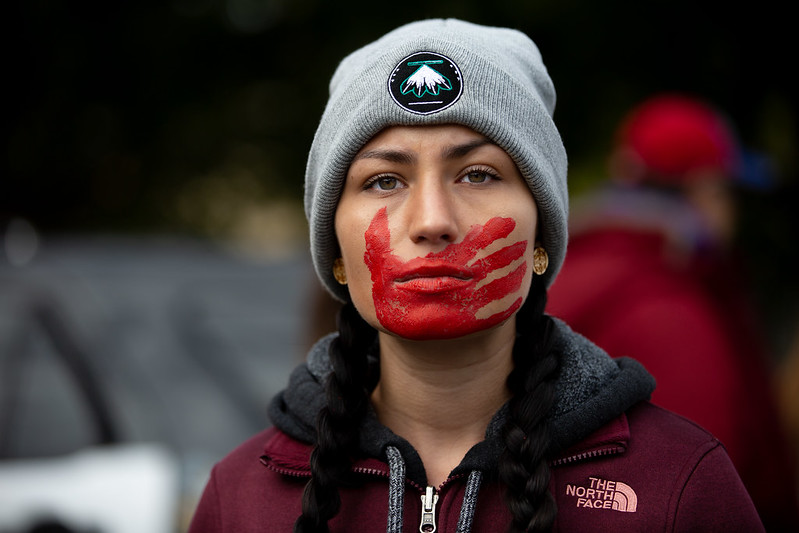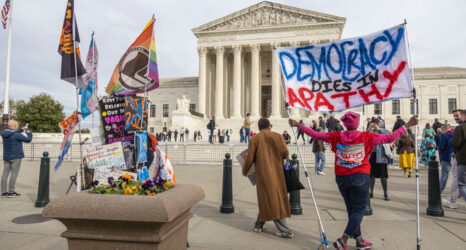Updated Oct. 12 at 8:45 a.m. PT.
Two bills addressing the epidemic of missing, murdered and trafficked Indigenous women—Savanna’s Act and the Not Invisible Act—were signed into law by President Trump on Sunday.

In August of 2017, a young pregnant woman named Savanna LaFontaine-Greywind was abducted and killed in Fargo, N.D. Savanna was one of over 5,646 American Indian and Alaska Native women and girls reported missing in 2017, according to the FBI’s National Crime Information Center.
Native American women are murdered at 10 times the national average. According to the National Institute of Justice, 84 percent of Native women experience violence in their lifetimes and 56 percent experience sexual violence. An astounding 97 percent of these women are victimized by non-Native perpetrators.
Late last month, Congress finally passed two laws—Savanna’s Act (named after Savanna LaFontaine-Greywind) and the Not Invisible Act—to address the epidemic of violence against Indigenous women in the United States.
On Sunday, after securing a signature from Trump, they become law of the land.
For years, the Coalition to Stop Violence Against Native Women and the National Indigenous Women’s Resource Institute have been sounding the alarm about missing and murdered indigenous women and girls (MMIWG), along with the Sovereign Bodies Institute and the Urban Indian Health Institute, among others.
“This has been a year of real visibility for the issue of missing and murdered indigenous women,” says Professor Sarah Deer, a member of the Muscogee (Creek) Nation of Oklahoma and expert on sexual violence against Native women. “There has been more attention drawn to it. And that’s largely the result of activism on the issue from policy organizations, direct service people, grassroots activists, families [of victims] and survivors.”
“It’s been a whirlwind of visibility. A perfect storm, in a good way.”
The MMIWG movement has held vigils, created databases to track those missing, organized marches and community meetings, and attended local city and tribal council meetings. Artist Jaime Black’s REDress Project at the Smithsonian’s National Museum of the American Indian used bright red dresses to represent the overwhelming number of women and girls missing from Native communities each year.
“You can’t understate the importance of grassroots activists, families and survivors coming forward,” says Deer. “It’s not easy for them to be in the public eye, but survivors and family members have been really important.”
The new laws are a result of the efforts of Deb Haaland, a Laguna Pueblo woman from New Mexico, and Sharice Davids, a member of the Ho-Chunk Nation from Kansas, who in 2019 joined the U.S. House of Representatives as the first Native American women ever to serve in Congress. They made passing legislation to address MMIWG a priority.
“All women deserve to live without fear of disappearing without a trace, but the missing and murdered indigenous women crisis persists and indigenous people continue to go missing. Today, we moved to say ‘enough is enough,’” said Rep. Haaland, co-chair of the Congressional Native American Caucus.
Savanna’s Act and the Not Invisible Act
Savanna’s Act directs the Department of Justice (DOJ) to create standardized procedures to address cases of missing or murdered Native American women, to work closely with tribal organizations and law enforcement agencies, and to report statistics on missing or murdered Native Americans to Congress every year. It also authorizes the DOJ to provide grants to train law enforcement agencies on how to handle these cases.
The Not Invisible Act focuses on violent crime against Natives more broadly, requiring the creation of an advisory committee made up of tribal leaders, law enforcement officers, families of victims, and survivors of violence. The committee is tasked with making recommendations to the DOJ and the Department of the Interior on how best to combat violence against Native Americans.
“A real solution to this crisis will never be found without the explicit inclusion of survivors, which is what is so special about this bill,” said Haaland.
She says the law requires “meaningful input from the survivors of these horrific crimes and Tribal leaders to ensure law enforcement has the guidance it needs to address missing persons cases from people who know the issue first hand.”
“What both of these bills will do is get everyone at the same table at the same time. That has been much harder than you would think,” says Deer, who testified on the bills before Congress last April.
They require coordination among the three federal agencies tasked with responding to crimes against Native Americans—the Department of Justice, the Department of Interior, and the Department of Health and Human Services.
“They haven’t traditionally always been on the same page,” Deer told Ms.
Savanna’s Act nearly became law in 2018, passing the Senate with unanimous consent. But one Republican representative, Bob Goodlatte of Massachusetts, used his last days in office to block a vote on the bill in the House due to “petty partisan games,” according to the bill’s author, former Sen. Heidi Heitkamp (D-N.D.).
So in 2019, when Reps. Haaland and Davids arrived in Congress, they immediately took up the fight. They co-sponsored the Not Invisible Act with Republican Representatives Tom Cole (La.) and Markwayne Mullin (Okla.), making it the first bill to be introduced by four enrolled members of federally recognized tribes—the Pueblo of Laguna, the Ho-Chunk Nation of Wisconsin, the Chickasaw Nation of Oklahoma, and the Cherokee Nation.
In the Senate, Sens. Lisa Murkowski (R-Alaska) and Catherine Cortez Masto (D-Nev.) reintroduced Savanna’s Act.
Murkowski’s support for the bill came after she came under fire for excluding Native Alaskans from a law allowing tribal courts to prosecute domestic violence committed by non-Natives. She later reversed her position and has been working hard to regain the trust and support of Native Alaskans.
While the president signed both bills on Sunday, Trump has a complex and difficult relationship with Native Americans, at times using slurs as political insults—such his repeated use of the racial slur “Pocahontas” to refer to Sen. Elizabeth Warren (D-Mass.).
In 2019, Trump issued an executive order creating a task force to investigate cases of missing Native American women—although Native activists criticized the order for excluding survivors and for not providing enough funding to address the severity of the issue. But in December, Trump signed into law three pro-tribal, bipartisan bills, so activists hope that he will sign the Not Invisible Act and Savanna’s Act too.
“Today’s signing puts us on a path towards greater justice for thousands of Native women and girls that have been missing, trafficked or taken far too soon and puts into place the tools needed to give our Native sisters, mothers and daughters greater security. No longer will these women be invisible, and may the memory of Savanna LaFontaine-Greywind live on in the law that bears her name,” said Sen. Catherine Cortez Masto (D-Nev.).
“I thank my colleague Senator Murkowski for leading this bill with me and the President for signing this bipartisan legislation.”





